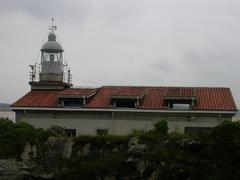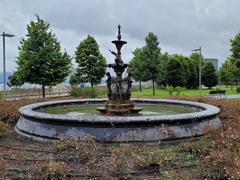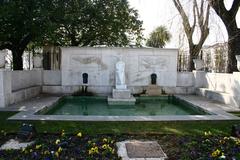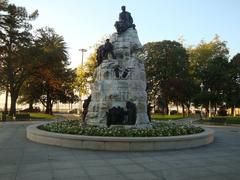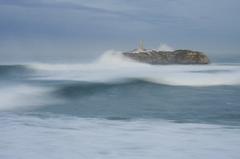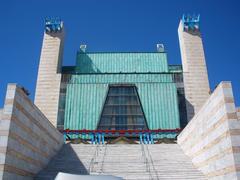
Visiting the Monument to Juan de la Cosa in Santander, Spain: Tickets, Hours, and Tips
Date: 03/07/2025
Introduction
The Monument to Juan de la Cosa is a powerful tribute to one of Spain’s most influential explorers, navigators, and cartographers. His pioneering work during the Age of Discovery, most notably creating the first known map of the Americas in 1500 and captaining the Santa María during Columbus’s first voyage in 1492, helped reshape the European understanding of the world. Located in Santander—specifically in the Jardines de Pereda and the Magdalena Peninsula—and in his birthplace of Santoña, these monuments offer visitors unique insights into Spain’s rich maritime legacy and Cantabria’s proud seafaring traditions.
Whether you are a history enthusiast, cultural traveler, or casual visitor, these monuments are gateways to understanding Spain’s pivotal role in global exploration. This guide covers essential details on visiting hours, ticket information, accessibility, travel tips, special events, and nearby attractions to ensure a rewarding experience. For the latest updates and guided audio tours, resources like the official Santander tourism website and the Audiala app are recommended. Embark on your journey and discover the enduring legacy of Juan de la Cosa in Cantabria’s breathtaking coastal landscapes.
(Santander Tourism, Spain.info, Museo Naval)
Table of Contents
- Introduction
- Monument Description and Historical Significance
- Visiting Information
- Accessibility
- How to Get There
- Nearby Attractions
- Special Events and Visitor Experiences
- Photographic Spots and Tips
- Recommended Itineraries and Visitor Experiences
- Frequently Asked Questions (FAQs)
- Conclusion and Call to Action
- References
Monument Description and Historical Significance
The Santander monument, designed by Victorio Macho in 1949, features a statue of Juan de la Cosa holding a map, symbolizing his contributions as a navigator and cartographer. Visitors can also see a detailed replica of the Santa María and the original mermaid figurehead, both displayed on the Magdalena Peninsula. In Santoña, the early 20th-century bronze statue, adorned with maritime motifs, stands as a prominent focal point in the town square, overlooking the Bay of Biscay. Both sites are freely accessible, wheelchair-friendly, and feature interpretive signage with occasional guided tours that illuminate de la Cosa’s legacy.
These monuments not only honor de la Cosa’s achievements but also embody Cantabria’s regional identity, celebrating its seafaring past. Educational programs and community events frequently incorporate the monuments, ensuring their continued cultural relevance.
Visiting Information
Santander
- Location: Jardines de Pereda and Magdalena Peninsula
- Hours: Open daily, 24 hours (public parks)
- Admission: Free
- Guided Tours: Available on weekends and holidays; check Santander Turismo for updates.
Santoña
- Location: Central plaza, near the waterfront
- Hours: Accessible year-round during daylight hours
- Admission: Free
- Guided Tours: Included in many local walking tours
Accessibility
Both Santander and Santoña monuments are wheelchair accessible, with paved paths and ramps. Designated parking spots for visitors with disabilities are available near both sites. Informational plaques are bilingual (Spanish and English), and QR codes link to digital resources for further learning.
How to Get There
- By Bus: City buses (routes 1, 2, or 3) serve the Magdalena Peninsula in Santander. Santoña is connected to Santander via regional buses.
- By Car: Parking is available near both monuments, but may be limited during peak times.
- Walking: Visitors in central Santander can reach the Jardines de Pereda and Magdalena Peninsula with a scenic 20-minute walk along the waterfront.
Nearby Attractions
-
Santander:
- Palacio de la Magdalena: A royal palace with guided tours and gardens.
- Maritime Museum of Cantabria: Nautical history and artifacts (Museo Marítimo del Cantábrico).
- Santander Beaches: Playa del Sardinero and others for seaside relaxation.
- Centro Botín: Contemporary art center with panoramic city views.
-
Santoña:
- Church of Santa María del Puerto: A Burgundian Gothic masterpiece.
- Santoña Waterfront: Promenades, seafood restaurants, and access to natural park marshlands.
Special Events and Visitor Experiences
Throughout the year, both monuments host maritime festivals, historical reenactments, and educational workshops. These events deepen engagement with the region’s maritime heritage and offer unique opportunities for interactive learning and celebration.
Photographic Spots and Tips
- Best Lighting: Early mornings and late afternoons.
- Iconic Shots: The replica Santa María and mermaid figurehead in Santander; the bronze statue and Bay of Biscay backdrop in Santoña.
- Seasonal Beauty: Visit in spring or summer for lush gardens and vibrant local activity.
Recommended Itineraries and Visitor Experiences
- Half-Day Walking Tour: Visit the monument, stroll through the Jardines de Pereda, explore the Magdalena Peninsula, and enjoy nearby museums and beaches.
- Family-Friendly Activities: Playgrounds, accessible paths, and interactive museum exhibits make the area suitable for visitors of all ages.
Frequently Asked Questions (FAQs)
Santander
Q: What are the opening hours?
A: Public parks are open 24/7; guided tours available on weekends/holidays.
Q: Is there an entrance fee?
A: No, both the monument and the park are free to visit.
Q: Is the monument wheelchair accessible?
A: Yes, with paved paths and ramps.
Q: Are guided tours available?
A: Yes, on weekends and public holidays.
Santoña
Q: What are the visiting hours?
A: Open during daylight hours, year-round.
Q: Is admission free?
A: Yes.
Q: Are there nearby attractions?
A: Yes, including the Church of Santa María del Puerto and the waterfront promenade.
Conclusion and Call to Action
The Monument to Juan de la Cosa in both Santander and Santoña offers a profound window into Spain’s maritime history and the Age of Discovery. With free, year-round access and a wealth of nearby attractions, these sites are essential for anyone interested in history, art, or the cultural heritage of Cantabria. For current information on tours, events, and accessibility, download the Audiala app and visit official tourism sites. Embrace the legacy of discovery and explore the region’s historical treasures firsthand.

